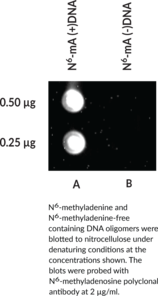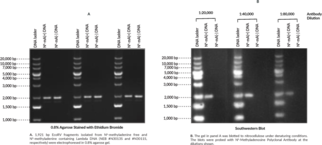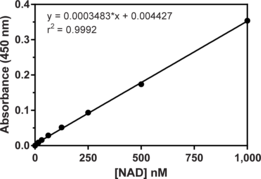Cayman
Showing 31501–31650 of 45550 results
-
N6-Methyladenosine is an adenosine analog.{48666} It inhibits epinephrine-induced contraction of isolated guinea pig ileum and thoracic aorta when used at a concentration of 10 μM. N6-Methyladenosine (1 mg/kg, i.v.) decreases arterial blood pressure and renal blood flow and increases peripheral resistance in anesthetized dogs.{48667} It also inhibits tumor growth in the C3H/ST and C3HB/ST mouse models of spontaneous mammary adenocarcinomas.{48668} N6-Methyladenosine is also the most prevelant mRNA modification in eukaryotes and has roles in cell viability and development.{35631}
Brand:CaymanSKU:28833 - 250 mgAvailable on backorder
N6-Methyladenosine is an adenosine analog.{48666} It inhibits epinephrine-induced contraction of isolated guinea pig ileum and thoracic aorta when used at a concentration of 10 μM. N6-Methyladenosine (1 mg/kg, i.v.) decreases arterial blood pressure and renal blood flow and increases peripheral resistance in anesthetized dogs.{48667} It also inhibits tumor growth in the C3H/ST and C3HB/ST mouse models of spontaneous mammary adenocarcinomas.{48668} N6-Methyladenosine is also the most prevelant mRNA modification in eukaryotes and has roles in cell viability and development.{35631}
Brand:CaymanSKU:28833 - 500 mgAvailable on backorder
N6-Methyladenosine 5′-monophosphate is an activator of glycogen phosphorylase b (Ka = 22 µM).{36175} It is also a non-competitive inhibitor of rat adenylate kinase II (Ki = 4.2 mM).{36174} N6-Methyladenosine 5’-monophosphate (sodium salt) has been used for immunoprecipitation of N6-methyladenosine.{36173}
Brand:CaymanSKU:23382 - 10 mgAvailable on backorder
N6-Methyladenosine 5′-monophosphate is an activator of glycogen phosphorylase b (Ka = 22 µM).{36175} It is also a non-competitive inhibitor of rat adenylate kinase II (Ki = 4.2 mM).{36174} N6-Methyladenosine 5’-monophosphate (sodium salt) has been used for immunoprecipitation of N6-methyladenosine.{36173}
Brand:CaymanSKU:23382 - 25 mgAvailable on backorder
N6-Methyladenosine 5′-monophosphate is an activator of glycogen phosphorylase b (Ka = 22 µM).{36175} It is also a non-competitive inhibitor of rat adenylate kinase II (Ki = 4.2 mM).{36174} N6-Methyladenosine 5’-monophosphate (sodium salt) has been used for immunoprecipitation of N6-methyladenosine.{36173}
Brand:CaymanSKU:23382 - 5 mgAvailable on backorder
Immunogen: N6-Methyladenosine conjugated to BSA • Clone: 17-3-4-1 • Host: Mouse • Isotype: IgG1k • Applications: Dot blot, ELISA, IP
Brand:CaymanSKU:18336- 100 µgAvailable on backorder
Immunogen: N6-Methyladenosine conjugated to BSA • Clone: 17-3-4-1 • Host: Mouse • Isotype: IgG1k • Applications: Dot blot, ELISA, IP
Brand:CaymanSKU:18336- 100 µgN6-Methyladenosine (m6A) is an abundant modification found in mRNA, tRNA, snRNA, as well as long non-coding RNA, in all species. RNA adenosine methylation is catalyzed by a multicomponent complex composed of METTL3/MT-A70, METTL14, and WTAP in mammals. METTL3 and METTL14 are responsible for the methyltransferase activity of the complex, and WTAP mediates substrate recruitment.{30057} The process shares similarities to histone methylation in that the modification is installed by m6A methylation “writers”, detected by methylation-specific “readers”, and can be reversed by demethylation “erasers”. The m6A modification has been shown to be conserved in the vicinity of stop codons and the 3’-untranslated region of specific mouse and human mRNAs.{25677} The process of regulating m6A modifications in mammalian mRNA has been linked to disease, where fat mass and obesity-associated (FTO) has been reported to be an obesity risk gene.{25677} FTO is an m6A demethylase and polymorphisms that result in increased FTO expression are associated with increased body mass and risk of obesity. Cayman’s N6-Methyladenosine Monoclonal Antibody (Clone 17-3-4-1) can be used for dot blot, ELISA, and immunoprecipitation applications.
Brand:CaymanSKU:18336 - 100 µgAvailable on backorder
Protein A-purified IgG • Immunogen: N6-Methyladenosine conjugated to KLH • Host: Rabbit • Applications: ELISA and Southwestern dot blot
Brand:CaymanSKU:18337- 1 eaAvailable on backorder
Protein A-purified IgG • Immunogen: N6-Methyladenosine conjugated to KLH • Host: Rabbit • Applications: ELISA and Southwestern dot blot
Brand:CaymanSKU:18337- 1 eaN6-Methyladenosine (m6A) is the most prevalent internal modification that occurs in the messenger RNAs (mRNAs) of most eukaryotes and has been linked to effects on mRNA fate. The process shares similarities to histone methylation in that the modification is installed by m6A methylation “writers”, detected by methylation-specific “readers”, and can be reversed by demethylation “erasers”. The m6A modification has been found to be highly conserved around stop codons, in 3’-untranslated region, and within long external exons in both human and mouse cells.{25677} The process of regulating m6A modifications in mammalian mRNA has been linked to disease, where fat mass and obesity-associated (FTO) has been reported to be an obesity risk gene.{25677} FTO is an m6A demethylase and polymorphisms that result in increased FTO expression are associated with increased body mass and risk of obesity. Cayman’s N6-Methyladenosine Polyclonal Antibody can be used for ELISA and Southwestern dot blot applications.
Brand:CaymanSKU:18337 - 1 eaAvailable on backorder
N6022 is a tight-binding, specific, and fully reversible inhibitor of S-nitrosoglutathione reductase (GSNOR; IC50 = 8 nM; Ki = 2.5 nM).{33360} It is reported to bind in the GSNO substrate binding pocket like a competitive inhibitor, although in kinetic assays it behaves with a mixed uncompetitive mode of inhibition toward the GSNO substrate and a mixed competitive mode of inhibition toward the formaldehyde adduct, S-hydroxymethylglutathione.{33360}
Brand:CaymanSKU:21269 -Out of stock
N6022 is a tight-binding, specific, and fully reversible inhibitor of S-nitrosoglutathione reductase (GSNOR; IC50 = 8 nM; Ki = 2.5 nM).{33360} It is reported to bind in the GSNO substrate binding pocket like a competitive inhibitor, although in kinetic assays it behaves with a mixed uncompetitive mode of inhibition toward the GSNO substrate and a mixed competitive mode of inhibition toward the formaldehyde adduct, S-hydroxymethylglutathione.{33360}
Brand:CaymanSKU:21269 -Out of stock
N6022 is a tight-binding, specific, and fully reversible inhibitor of S-nitrosoglutathione reductase (GSNOR; IC50 = 8 nM; Ki = 2.5 nM).{33360} It is reported to bind in the GSNO substrate binding pocket like a competitive inhibitor, although in kinetic assays it behaves with a mixed uncompetitive mode of inhibition toward the GSNO substrate and a mixed competitive mode of inhibition toward the formaldehyde adduct, S-hydroxymethylglutathione.{33360}
Brand:CaymanSKU:21269 -Out of stock
N6022 is a tight-binding, specific, and fully reversible inhibitor of S-nitrosoglutathione reductase (GSNOR; IC50 = 8 nM; Ki = 2.5 nM).{33360} It is reported to bind in the GSNO substrate binding pocket like a competitive inhibitor, although in kinetic assays it behaves with a mixed uncompetitive mode of inhibition toward the GSNO substrate and a mixed competitive mode of inhibition toward the formaldehyde adduct, S-hydroxymethylglutathione.{33360}
Brand:CaymanSKU:21269 -Out of stock
NAB 2 is an inhibitor of α-synuclein-induced toxicity.{46118} It prevents α-synuclein-induced defects in Rsp5-dependent endocytosis and vacuolar delivery of Mup1, Golgi-to-vacuole trafficking of Sna3, and degradation of Bap2 in wild-type yeast cells. NAB 2 also prevents formation of α-synuclein foci in wild-type yeast cells, an effect that is prevented by the rsp5G747E point mutation.
Brand:CaymanSKU:26145 - 1 mgAvailable on backorder
NAB 2 is an inhibitor of α-synuclein-induced toxicity.{46118} It prevents α-synuclein-induced defects in Rsp5-dependent endocytosis and vacuolar delivery of Mup1, Golgi-to-vacuole trafficking of Sna3, and degradation of Bap2 in wild-type yeast cells. NAB 2 also prevents formation of α-synuclein foci in wild-type yeast cells, an effect that is prevented by the rsp5G747E point mutation.
Brand:CaymanSKU:26145 - 10 mgAvailable on backorder
NAB 2 is an inhibitor of α-synuclein-induced toxicity.{46118} It prevents α-synuclein-induced defects in Rsp5-dependent endocytosis and vacuolar delivery of Mup1, Golgi-to-vacuole trafficking of Sna3, and degradation of Bap2 in wild-type yeast cells. NAB 2 also prevents formation of α-synuclein foci in wild-type yeast cells, an effect that is prevented by the rsp5G747E point mutation.
Brand:CaymanSKU:26145 - 5 mgAvailable on backorder
Nabumetone is a non-steroidal anti-inflammatory drug (NSAID) and a prodrug form of 6-methoxy naphthalene acetic acid (Item No. 70620).{32442} Nabumetone (5-45 mg/kg) reduces carrageenan-induced edema in rats, as well as UV-induced erythema in guinea pigs (ED50 = 11 mg/kg).{32441} It reduces phenyl-p-quinone-induced writhing in mice (ED50 = 152 mg/kg). Nabumetone (50, 100, and 200 mg/kg) reduces endotoxin-induced pyresis in rabbits.
Brand:CaymanSKU:20251 -Available on backorder
Nabumetone is a non-steroidal anti-inflammatory drug (NSAID) and a prodrug form of 6-methoxy naphthalene acetic acid (Item No. 70620).{32442} Nabumetone (5-45 mg/kg) reduces carrageenan-induced edema in rats, as well as UV-induced erythema in guinea pigs (ED50 = 11 mg/kg).{32441} It reduces phenyl-p-quinone-induced writhing in mice (ED50 = 152 mg/kg). Nabumetone (50, 100, and 200 mg/kg) reduces endotoxin-induced pyresis in rabbits.
Brand:CaymanSKU:20251 -Available on backorder
Nabumetone is a non-steroidal anti-inflammatory drug (NSAID) and a prodrug form of 6-methoxy naphthalene acetic acid (Item No. 70620).{32442} Nabumetone (5-45 mg/kg) reduces carrageenan-induced edema in rats, as well as UV-induced erythema in guinea pigs (ED50 = 11 mg/kg).{32441} It reduces phenyl-p-quinone-induced writhing in mice (ED50 = 152 mg/kg). Nabumetone (50, 100, and 200 mg/kg) reduces endotoxin-induced pyresis in rabbits.
Brand:CaymanSKU:20251 -Available on backorder
Nabumetone is a non-steroidal anti-inflammatory drug (NSAID) and a prodrug form of 6-methoxy naphthalene acetic acid (Item No. 70620).{32442} Nabumetone (5-45 mg/kg) reduces carrageenan-induced edema in rats, as well as UV-induced erythema in guinea pigs (ED50 = 11 mg/kg).{32441} It reduces phenyl-p-quinone-induced writhing in mice (ED50 = 152 mg/kg). Nabumetone (50, 100, and 200 mg/kg) reduces endotoxin-induced pyresis in rabbits.
Brand:CaymanSKU:20251 -Available on backorder
Nabumetone-d3 is intended for use as an internal standard for the quantification of nabumetone (Item No. 20251) by GC- or LC-MS. Nabumetone is a non-steroidal anti-inflammatory drug (NSAID) and a prodrug form of 6-methoxy naphthalene acetic acid (Item No. 70620).{32442} Nabumetone (5-45 mg/kg) reduces carrageenan-induced edema in rats, as well as UV-induced erythema in guinea pigs (ED50 = 11 mg/kg).{32441} It reduces phenyl-p-quinone-induced writhing in mice (ED50 = 152 mg/kg). Nabumetone (50, 100, and 200 mg/kg) reduces endotoxin-induced pyresis in rabbits.
Brand:CaymanSKU:30721 - 1 mgAvailable on backorder
Nicotinamide adenine dinucleotide (NAD) exists in an oxidized form, NAD+, as well as a reduced form, NADH. NAD, the main free form in cells, functions in modulating cellular redox status and by controlling signaling and transcriptional events, making it an important cofactor when investigating normal cellular function. Cayman’s NAD/NADH Cell-Based Assay Kit provides a colorimetric method for measuring intracellular NAD+ and NADH in cultured cells. In this assay, NAD+ found in cell samples is reduced to NADH by alcohol dehydrogenase during the oxidation of ethanol to acetaldehyde. The newly formed and the existing NADH found in the samples is then oxidized resulting in the reduction of a tetrazolium salt substrate (WST-1) to a highly-colored formazan which absorbs at 450 nm. The amount of formazan produced is proportional to the amount of total NAD in the cell lysate and can be used as an indicator of the total cellular NAD concentration.
Brand:CaymanSKU:600480 - 1 eaAvailable on backorder
NAD+, known more formally as nicotinamide adenine dinucleotide, is a signaling molecule as well as a cofactor or substrate for many enzymes.{20368} It acts as an oxidizing agent, accepting electrons from other molecules while being converted to its reduced form, NADH (Item No. 16078).{20368} NAD+ is also essential for the activity of several enzymes, including poly(ADP)-ribose polymerases and cADP-ribose synthases.{20368} For example, it is used by some sirtuins to mediate protein deacetylation, producing O-acetyl-ADP-ribose and nicotinamide as well as the deacetylated protein.{16292}
Brand:CaymanSKU:-NAD+, known more formally as nicotinamide adenine dinucleotide, is a signaling molecule as well as a cofactor or substrate for many enzymes.{20368} It acts as an oxidizing agent, accepting electrons from other molecules while being converted to its reduced form, NADH (Item No. 16078).{20368} NAD+ is also essential for the activity of several enzymes, including poly(ADP)-ribose polymerases and cADP-ribose synthases.{20368} For example, it is used by some sirtuins to mediate protein deacetylation, producing O-acetyl-ADP-ribose and nicotinamide as well as the deacetylated protein.{16292}
Brand:CaymanSKU:-NAD+, known more formally as nicotinamide adenine dinucleotide, is a signaling molecule as well as a cofactor or substrate for many enzymes.{20368} It acts as an oxidizing agent, accepting electrons from other molecules while being converted to its reduced form, NADH (Item No. 16078).{20368} NAD+ is also essential for the activity of several enzymes, including poly(ADP)-ribose polymerases and cADP-ribose synthases.{20368} For example, it is used by some sirtuins to mediate protein deacetylation, producing O-acetyl-ADP-ribose and nicotinamide as well as the deacetylated protein.{16292}
Brand:CaymanSKU:-NADH is the reduced form of nicotinamide adenine dinucleotide (NAD) that can donate electrons as part of a reducing reaction. In that process, NADH becomes oxidized to produce NAD+ (Item No. 16077). A variety of enzymes use NADH plus H+ to reduce substrates, generating NAD+ as well as the reduced product.{24341,9247,24936} For example, NADH:ubiquinone oxidoreductase accepts two electrons from NADH and passes them to ubiquinone (coenzyme Q) as part of the mitochondrial electron transport chain.{24936}
Brand:CaymanSKU:-NADH is the reduced form of nicotinamide adenine dinucleotide (NAD) that can donate electrons as part of a reducing reaction. In that process, NADH becomes oxidized to produce NAD+ (Item No. 16077). A variety of enzymes use NADH plus H+ to reduce substrates, generating NAD+ as well as the reduced product.{24341,9247,24936} For example, NADH:ubiquinone oxidoreductase accepts two electrons from NADH and passes them to ubiquinone (coenzyme Q) as part of the mitochondrial electron transport chain.{24936}
Brand:CaymanSKU:-NADH is the reduced form of nicotinamide adenine dinucleotide (NAD) that can donate electrons as part of a reducing reaction. In that process, NADH becomes oxidized to produce NAD+ (Item No. 16077). A variety of enzymes use NADH plus H+ to reduce substrates, generating NAD+ as well as the reduced product.{24341,9247,24936} For example, NADH:ubiquinone oxidoreductase accepts two electrons from NADH and passes them to ubiquinone (coenzyme Q) as part of the mitochondrial electron transport chain.{24936}
Brand:CaymanSKU:-Brand:CaymanSKU:700932 - 500 µgAvailable on backorder
Nadifloxacin is a fluoroquinolone antibiotic that is used topically. It is effective against the Gram-positive bacteria S. aureus and P. acnes, as well as Gram-negative bacteria.{27493,32024,32025}
Brand:CaymanSKU:20252 -Available on backorder
Nadifloxacin is a fluoroquinolone antibiotic that is used topically. It is effective against the Gram-positive bacteria S. aureus and P. acnes, as well as Gram-negative bacteria.{27493,32024,32025}
Brand:CaymanSKU:20252 -Available on backorder
Nadifloxacin is a fluoroquinolone antibiotic that is used topically. It is effective against the Gram-positive bacteria S. aureus and P. acnes, as well as Gram-negative bacteria.{27493,32024,32025}
Brand:CaymanSKU:20252 -Available on backorder
Nadifloxacin is a fluoroquinolone antibiotic that is used topically. It is effective against the Gram-positive bacteria S. aureus and P. acnes, as well as Gram-negative bacteria.{27493,32024,32025}
Brand:CaymanSKU:20252 -Available on backorder
NADP+ is the oxidized form of the electron donor nicotinamide adenine dinucleotide phosphate (NADPH, Item No. 9000743). It serves as a cofactor in various biological reactions.{26206,26203} In addition, the balance between these reduced and oxidized forms plays key roles in diverse cellular functions, including cell survival, the maintenance of redox status, and intracellular signaling.{26203,26205} For example, binding of NADP+ to β-subunits of Kv channels activates ion transport, whereas NADPH stabilizes channel inactivation.{26202} NADP+ is biosynthesized from NAD+ (Item No. 16077) by NAD kinase, with ATP as the phosphoryl donor.{26204}
Brand:CaymanSKU:10004675 - 1 gAvailable on backorder
NADP+ is the oxidized form of the electron donor nicotinamide adenine dinucleotide phosphate (NADPH, Item No. 9000743). It serves as a cofactor in various biological reactions.{26206,26203} In addition, the balance between these reduced and oxidized forms plays key roles in diverse cellular functions, including cell survival, the maintenance of redox status, and intracellular signaling.{26203,26205} For example, binding of NADP+ to β-subunits of Kv channels activates ion transport, whereas NADPH stabilizes channel inactivation.{26202} NADP+ is biosynthesized from NAD+ (Item No. 16077) by NAD kinase, with ATP as the phosphoryl donor.{26204}
Brand:CaymanSKU:10004675 - 100 mgAvailable on backorder
NADP+ is the oxidized form of the electron donor nicotinamide adenine dinucleotide phosphate (NADPH, Item No. 9000743). It serves as a cofactor in various biological reactions.{26206,26203} In addition, the balance between these reduced and oxidized forms plays key roles in diverse cellular functions, including cell survival, the maintenance of redox status, and intracellular signaling.{26203,26205} For example, binding of NADP+ to β-subunits of Kv channels activates ion transport, whereas NADPH stabilizes channel inactivation.{26202} NADP+ is biosynthesized from NAD+ (Item No. 16077) by NAD kinase, with ATP as the phosphoryl donor.{26204}
Brand:CaymanSKU:10004675 - 250 mgAvailable on backorder
NADP+ is the oxidized form of the electron donor nicotinamide adenine dinucleotide phosphate (NADPH, Item No. 9000743). It serves as a cofactor in various biological reactions.{26206,26203} In addition, the balance between these reduced and oxidized forms plays key roles in diverse cellular functions, including cell survival, the maintenance of redox status, and intracellular signaling.{26203,26205} For example, binding of NADP+ to β-subunits of Kv channels activates ion transport, whereas NADPH stabilizes channel inactivation.{26202} NADP+ is biosynthesized from NAD+ (Item No. 16077) by NAD kinase, with ATP as the phosphoryl donor.{26204}
Brand:CaymanSKU:10004675 - 50 mgAvailable on backorder
NADPH is the reduced form of the electron acceptor nicotinamide adenine dinucleotide phosphate (NADP+) and acts as an electron donor in various biological reactions. In plants, NADPH is produced by ferredoxin-NADP+ reductase in the last step of the electron chain during photosynthesis. In animals it is predominantly produced by the pentose phosphate pathway, but it is also generated by key mitochondrial enzymes. NADPH provides the reducing equivalents for biosynthetic reactions and the oxidation-reduction involved in protecting against the toxicity of reactive oxygen species.{17018,2511,17024} It is also used for the synthesis of lipids and cholesterol and during the process of fatty acid chain elongation.{5994}
Brand:CaymanSKU:20945 -Out of stock
NADPH is the reduced form of the electron acceptor nicotinamide adenine dinucleotide phosphate (NADP+) and acts as an electron donor in various biological reactions. In plants, NADPH is produced by ferredoxin-NADP+ reductase in the last step of the electron chain during photosynthesis. In animals it is predominantly produced by the pentose phosphate pathway, but it is also generated by key mitochondrial enzymes. NADPH provides the reducing equivalents for biosynthetic reactions and the oxidation-reduction involved in protecting against the toxicity of reactive oxygen species.{17018,2511,17024} It is also used for the synthesis of lipids and cholesterol and during the process of fatty acid chain elongation.{5994}
Brand:CaymanSKU:20945 -Out of stock
NADPH is the reduced form of the electron acceptor nicotinamide adenine dinucleotide phosphate (NADP+) and acts as an electron donor in various biological reactions. In plants, NADPH is produced by ferredoxin-NADP+ reductase in the last step of the electron chain during photosynthesis. In animals it is predominantly produced by the pentose phosphate pathway, but it is also generated by key mitochondrial enzymes. NADPH provides the reducing equivalents for biosynthetic reactions and the oxidation-reduction involved in protecting against the toxicity of reactive oxygen species.{17018,2511,17024} It is also used for the synthesis of lipids and cholesterol and during the process of fatty acid chain elongation.{5994}
Brand:CaymanSKU:20945 -Out of stock
NADPH is the reduced form of the electron acceptor nicotinamide adenine dinucleotide phosphate (NADP+) and acts as an electron donor in various biological reactions. In plants, NADPH is produced by ferredoxin-NADP+ reductase in the last step of the electron chain during photosynthesis. In animals it is predominantly produced by the pentose phosphate pathway, but it is also generated by key mitochondrial enzymes. NADPH provides the reducing equivalents for biosynthetic reactions and the oxidation-reduction involved in protecting against the toxicity of reactive oxygen species.{17018,2511,17024} It is also used for the synthesis of lipids and cholesterol and during the process of fatty acid chain elongation.{5994}
Brand:CaymanSKU:20945 -Out of stock
NADPH is the reduced form of the electron acceptor nicotinamide adenine dinucleotide phosphate (NADP+) and acts as an electron donor in various biological reactions. In plants, NADPH is produced by ferredoxin-NADP+ reductase in the last step of the electron chain during photosynthesis. In animals is it predominantly produced by the pentose phosphate pathway, but is also generated by key mitochondrial enzymes. NADPH provides the reducing equivalents for biosynthetic reactions and the oxidation-reduction involved in protecting against the toxicity of reactive oxygen species.{17018,2511,17024} It is also used for the synthesis of lipids and cholesterol and during the process of fatty acid chain elongation.{5994}
Brand:CaymanSKU:9000743 - 100 mgAvailable on backorder
NADPH is the reduced form of the electron acceptor nicotinamide adenine dinucleotide phosphate (NADP+) and acts as an electron donor in various biological reactions. In plants, NADPH is produced by ferredoxin-NADP+ reductase in the last step of the electron chain during photosynthesis. In animals is it predominantly produced by the pentose phosphate pathway, but is also generated by key mitochondrial enzymes. NADPH provides the reducing equivalents for biosynthetic reactions and the oxidation-reduction involved in protecting against the toxicity of reactive oxygen species.{17018,2511,17024} It is also used for the synthesis of lipids and cholesterol and during the process of fatty acid chain elongation.{5994}
Brand:CaymanSKU:9000743 - 25 mgAvailable on backorder
NADPH is the reduced form of the electron acceptor nicotinamide adenine dinucleotide phosphate (NADP+) and acts as an electron donor in various biological reactions. In plants, NADPH is produced by ferredoxin-NADP+ reductase in the last step of the electron chain during photosynthesis. In animals is it predominantly produced by the pentose phosphate pathway, but is also generated by key mitochondrial enzymes. NADPH provides the reducing equivalents for biosynthetic reactions and the oxidation-reduction involved in protecting against the toxicity of reactive oxygen species.{17018,2511,17024} It is also used for the synthesis of lipids and cholesterol and during the process of fatty acid chain elongation.{5994}
Brand:CaymanSKU:9000743 - 250 mgAvailable on backorder
NADPH is the reduced form of the electron acceptor nicotinamide adenine dinucleotide phosphate (NADP+) and acts as an electron donor in various biological reactions. In plants, NADPH is produced by ferredoxin-NADP+ reductase in the last step of the electron chain during photosynthesis. In animals is it predominantly produced by the pentose phosphate pathway, but is also generated by key mitochondrial enzymes. NADPH provides the reducing equivalents for biosynthetic reactions and the oxidation-reduction involved in protecting against the toxicity of reactive oxygen species.{17018,2511,17024} It is also used for the synthesis of lipids and cholesterol and during the process of fatty acid chain elongation.{5994}
Brand:CaymanSKU:9000743 - 50 mgAvailable on backorder
Nafamostat is a serine protease inhibitor that is capable of inhibiting trypsin (a digestive system protease; Ki = 15 nM), tryptase (a mast cell protease; Ki = 95.3 pM), and additional proteases in the coagulation cascade including thrombin (Ki = 0.84 μM).{23663} In a mouse model of allergic asthma, a dose of 300 mg/kg nafamostat mesylate has been shown to inhibit serine proteolytic activity, to decrease circulating levels of eosinophils and lymphocytes in bronchoalveolar lavage fluid, and to reduce interleukin-13 and eotaxin production associated with antigen-induced airway eosinophilia and goblet cell hyperplasia.{23662}
Brand:CaymanSKU:-Nafamostat is a serine protease inhibitor that is capable of inhibiting trypsin (a digestive system protease; Ki = 15 nM), tryptase (a mast cell protease; Ki = 95.3 pM), and additional proteases in the coagulation cascade including thrombin (Ki = 0.84 μM).{23663} In a mouse model of allergic asthma, a dose of 300 mg/kg nafamostat mesylate has been shown to inhibit serine proteolytic activity, to decrease circulating levels of eosinophils and lymphocytes in bronchoalveolar lavage fluid, and to reduce interleukin-13 and eotaxin production associated with antigen-induced airway eosinophilia and goblet cell hyperplasia.{23662}
Brand:CaymanSKU:-Nafamostat is a serine protease inhibitor that is capable of inhibiting trypsin (a digestive system protease; Ki = 15 nM), tryptase (a mast cell protease; Ki = 95.3 pM), and additional proteases in the coagulation cascade including thrombin (Ki = 0.84 μM).{23663} In a mouse model of allergic asthma, a dose of 300 mg/kg nafamostat mesylate has been shown to inhibit serine proteolytic activity, to decrease circulating levels of eosinophils and lymphocytes in bronchoalveolar lavage fluid, and to reduce interleukin-13 and eotaxin production associated with antigen-induced airway eosinophilia and goblet cell hyperplasia.{23662}
Brand:CaymanSKU:-Nafarelin is an agonist of gonadotropin-releasing hormone (GNRH).{40488,40489,40490} It is a long-acting agent that, after an initial increase in sex hormone levels, decreases the level of circulating gonadotropins and sex hormones. In vivo, nafarelin (0.5-2.0 μg/kg, s.c.) reduces plasma levels of luteinizing hormone and testosterone (Item Nos. 15645 | ISO60154) as well as testicular volume, sperm count, sperm motility, and duration of ejaculation in male dogs.{40488} Nafarelin (32 μg/animal per day) inhibits estrus in female beagle dogs.{40489} It also reduces the volume of endometrial tissue in a rat model of endometriosis.{40490} Formulations containing nafarelin have been used in the treatment of endometriosis and central precocious puberty.
Brand:CaymanSKU:24070 - 1 mgAvailable on backorder
Nafarelin is an agonist of gonadotropin-releasing hormone (GNRH).{40488,40489,40490} It is a long-acting agent that, after an initial increase in sex hormone levels, decreases the level of circulating gonadotropins and sex hormones. In vivo, nafarelin (0.5-2.0 μg/kg, s.c.) reduces plasma levels of luteinizing hormone and testosterone (Item Nos. 15645 | ISO60154) as well as testicular volume, sperm count, sperm motility, and duration of ejaculation in male dogs.{40488} Nafarelin (32 μg/animal per day) inhibits estrus in female beagle dogs.{40489} It also reduces the volume of endometrial tissue in a rat model of endometriosis.{40490} Formulations containing nafarelin have been used in the treatment of endometriosis and central precocious puberty.
Brand:CaymanSKU:24070 - 10 mgAvailable on backorder
Nafarelin is an agonist of gonadotropin-releasing hormone (GNRH).{40488,40489,40490} It is a long-acting agent that, after an initial increase in sex hormone levels, decreases the level of circulating gonadotropins and sex hormones. In vivo, nafarelin (0.5-2.0 μg/kg, s.c.) reduces plasma levels of luteinizing hormone and testosterone (Item Nos. 15645 | ISO60154) as well as testicular volume, sperm count, sperm motility, and duration of ejaculation in male dogs.{40488} Nafarelin (32 μg/animal per day) inhibits estrus in female beagle dogs.{40489} It also reduces the volume of endometrial tissue in a rat model of endometriosis.{40490} Formulations containing nafarelin have been used in the treatment of endometriosis and central precocious puberty.
Brand:CaymanSKU:24070 - 5 mgAvailable on backorder
Nafarelin is an agonist of gonadotropin-releasing hormone (GNRH).{40488,40489,40490} It is a long-acting agent that, after an initial increase in sex hormone levels, decreases the level of circulating gonadotropins and sex hormones. In vivo, nafarelin (0.5-2.0 μg/kg, s.c.) reduces plasma levels of luteinizing hormone and testosterone (Item Nos. 15645 | ISO60154) as well as testicular volume, sperm count, sperm motility, and duration of ejaculation in male dogs.{40488} Nafarelin (32 μg/animal per day) inhibits estrus in female beagle dogs.{40489} It also reduces the volume of endometrial tissue in a rat model of endometriosis.{40490} Formulations containing nafarelin have been used in the treatment of endometriosis and central precocious puberty.
Brand:CaymanSKU:24070 - 500 µgAvailable on backorder
Nafcillin is a semisynthetic β-lactam antibiotic that shows resistance to staphylococcal penicillinase.{32140} Nafcillin is particularly effective against methicillin-sensitive strains of S. aureus, as shown in animal models and clinical trials.{32974,32975}
Brand:CaymanSKU:21008 -Out of stock
Nafcillin is a semisynthetic β-lactam antibiotic that shows resistance to staphylococcal penicillinase.{32140} Nafcillin is particularly effective against methicillin-sensitive strains of S. aureus, as shown in animal models and clinical trials.{32974,32975}
Brand:CaymanSKU:21008 -Out of stock
Nafcillin is a semisynthetic β-lactam antibiotic that shows resistance to staphylococcal penicillinase.{32140} Nafcillin is particularly effective against methicillin-sensitive strains of S. aureus, as shown in animal models and clinical trials.{32974,32975}
Brand:CaymanSKU:21008 -Out of stock
Nafcillin is a semisynthetic β-lactam antibiotic that shows resistance to staphylococcal penicillinase.{32140} Nafcillin is particularly effective against methicillin-sensitive strains of S. aureus, as shown in animal models and clinical trials.{32974,32975}
Brand:CaymanSKU:21008 -Out of stock
Naftifine is an allylamine compound that blocks ergosterol biosynthesis in fungi by inhibiting squalene epoxidase (Ki = 1.1 µM for C. albicans epoxidase).{17902}
Brand:CaymanSKU:-Available on backorder
Naftifine is an allylamine compound that blocks ergosterol biosynthesis in fungi by inhibiting squalene epoxidase (Ki = 1.1 µM for C. albicans epoxidase).{17902}
Brand:CaymanSKU:-Available on backorder
Naftifine is an allylamine compound that blocks ergosterol biosynthesis in fungi by inhibiting squalene epoxidase (Ki = 1.1 µM for C. albicans epoxidase).{17902}
Brand:CaymanSKU:-Available on backorder
Naftifine is an allylamine compound that blocks ergosterol biosynthesis in fungi by inhibiting squalene epoxidase (Ki = 1.1 µM for C. albicans epoxidase).{17902}
Brand:CaymanSKU:-Available on backorder
Naftifine-d3 is intended for use as an internal standard for the quantification of naftifine (Item No. 19234) by GC- or LC-MS. Naftifine is an allylamine compound that blocks ergosterol biosynthesis in fungi by inhibiting squalene epoxidase (Ki = 1.1 µM for C. albicans epoxidase).{17902}
Brand:CaymanSKU:29413 - 1 mgAvailable on backorder
Naftopidil is an α1-adrenergic receptor antagonist that competitively inhibits α-adrenoceptor-mediated contractions induced by noradrenaline with pA2 values of 6.73-8.15 in various blood vessels from dog, rabbit, guinea pig, and rat.{33266} It binds to the cloned human α1-adrenergic receptors with Ki values of 3.7, 20, and 1.2 nM for α1A, α1B and α1D, respectively.{33264} Clinical formulations of naftopidil are used in the treatment of benign prostatic hyperplasia in Japan.{33264} Naftopidil also exhibits antiproliferative activity, inhibiting the growth of androgen-sensitive LNcaP cells and androgen-insensitive PC-3 cancer cell lines with IC50 values of 22.2 and 33.2 µM, respectively.{33265}
Brand:CaymanSKU:21122 -Out of stock
Naftopidil is an α1-adrenergic receptor antagonist that competitively inhibits α-adrenoceptor-mediated contractions induced by noradrenaline with pA2 values of 6.73-8.15 in various blood vessels from dog, rabbit, guinea pig, and rat.{33266} It binds to the cloned human α1-adrenergic receptors with Ki values of 3.7, 20, and 1.2 nM for α1A, α1B and α1D, respectively.{33264} Clinical formulations of naftopidil are used in the treatment of benign prostatic hyperplasia in Japan.{33264} Naftopidil also exhibits antiproliferative activity, inhibiting the growth of androgen-sensitive LNcaP cells and androgen-insensitive PC-3 cancer cell lines with IC50 values of 22.2 and 33.2 µM, respectively.{33265}
Brand:CaymanSKU:21122 -Out of stock
Naftopidil is an α1-adrenergic receptor antagonist that competitively inhibits α-adrenoceptor-mediated contractions induced by noradrenaline with pA2 values of 6.73-8.15 in various blood vessels from dog, rabbit, guinea pig, and rat.{33266} It binds to the cloned human α1-adrenergic receptors with Ki values of 3.7, 20, and 1.2 nM for α1A, α1B and α1D, respectively.{33264} Clinical formulations of naftopidil are used in the treatment of benign prostatic hyperplasia in Japan.{33264} Naftopidil also exhibits antiproliferative activity, inhibiting the growth of androgen-sensitive LNcaP cells and androgen-insensitive PC-3 cancer cell lines with IC50 values of 22.2 and 33.2 µM, respectively.{33265}
Brand:CaymanSKU:21122 -Out of stock
Naftopidil is an α1-adrenergic receptor antagonist that competitively inhibits α-adrenoceptor-mediated contractions induced by noradrenaline with pA2 values of 6.73-8.15 in various blood vessels from dog, rabbit, guinea pig, and rat.{33266} It binds to the cloned human α1-adrenergic receptors with Ki values of 3.7, 20, and 1.2 nM for α1A, α1B and α1D, respectively.{33264} Clinical formulations of naftopidil are used in the treatment of benign prostatic hyperplasia in Japan.{33264} Naftopidil also exhibits antiproliferative activity, inhibiting the growth of androgen-sensitive LNcaP cells and androgen-insensitive PC-3 cancer cell lines with IC50 values of 22.2 and 33.2 µM, respectively.{33265}
Brand:CaymanSKU:21122 -Out of stock
Nalanthalide is a diterpenoid pyrone fungal metabolite that has been found in Nalanthamala and has potassium channel inhibitory and antiviral activities.{53575} It inhibits binding of the potassium channel inhibitor charybdotoxin (Item No. 24115) to Jurkat cell membranes (IC50 = 3 µM) and inhibits rubidium efflux from CHO cells expressing the voltage-gated potassium (Kv) channel Kv1.3 (IC50 = 3.9 µM). Nalanthalide depolarizes T cells in vitro with an EC50 value of 500 nM. It also inhibits HIV-1 integrase activity with IC50 values of 10 and 25 µM in coupled and strand transfer assays, respectively.{37200}
Brand:CaymanSKU:29724 - 1 mgAvailable on backorder
Naldemedine is a peripherally acting opioid receptor antagonist (IC50s = 1.15, 1.11, and 1.5 nM for recombinant human μ-, δ-, and κ-opioid receptors, respectively).{48812,48813} It inhibits opioid-induced emesis and vomiting in ferrets and opioid-induced constipation in rats (ED50 = 0.03 mg/kg for both) without affecting the analgesic effect of morphine in the tail-flick test in rats.{48812} Naldemedine induces the opioid withdrawal symptoms of diarrhea and teeth chattering, but not jumping, in morphine-dependent rats when administered at doses of 1 and 3 mg/kg, respectively.{48813} Formulations containing naldemedine have been used in the treatment of opioid-induced constipation.
Brand:CaymanSKU:29570 - 500 µgAvailable on backorder
Naled is an organophosphate insecticide and acaricide that inhibits acetylcholinesterase (AChE) and butyrylcholinesterase (BChE).{43652} It reduces the number of A. sollicitans mosquitos by 97% after one hour when aerially applied at a concentration of 0.1 pounds per acre.{43653} Naled (125 ppm AI) induces 100 and 64% mortality of T. telarius adults and immature mites, respectively, in an immediate contact toxicity test but does not induce mortality in mite eggs.{43654} It is toxic to rats with an LD50 value of 250 mg/kg.{41952} Formulations containing naled have been used in the control of mosquitoes in public areas and of crop-damaging insects in agriculture.
Brand:CaymanSKU:25783 - 100 mgAvailable on backorder
Nalfurafine is a κ-opioid receptor (KOR) agonist (EC50 = 0.05 nM for human receptors expressed in CHO cell membranes).{49051} It is selective for κ-opioid over μ- and δ-opioid receptors (EC50s = 0.72 and 74.1 nM, respectively). Nalfurafine (≥30 μg/kg) reduces scratching behavior induced by chloroquine (CQ; Item No. 14194) in mice, as well as locomotor activity when administered at a dose of 100 μg/kg.{49053} In rats, nalfurafine (≥0.01 mg/kg) reduces intracranial self-stimulation, lactic acid-induced stretching behavior, and scratching behavior induced by intradermal administration of serotonin (5-HT; Item No. 14332).{49054} Nalfurafine is also an orexin 1 receptor (OX1R) antagonist (Ki = 250 nM).{49052}
Brand:CaymanSKU:23186 - 1 mgAvailable on backorder
Nalfurafine is a κ-opioid receptor (KOR) agonist (EC50 = 0.05 nM for human receptors expressed in CHO cell membranes).{49051} It is selective for κ-opioid over μ- and δ-opioid receptors (EC50s = 0.72 and 74.1 nM, respectively). Nalfurafine (≥30 μg/kg) reduces scratching behavior induced by chloroquine (CQ; Item No. 14194) in mice, as well as locomotor activity when administered at a dose of 100 μg/kg.{49053} In rats, nalfurafine (≥0.01 mg/kg) reduces intracranial self-stimulation, lactic acid-induced stretching behavior, and scratching behavior induced by intradermal administration of serotonin (5-HT; Item No. 14332).{49054} Nalfurafine is also an orexin 1 receptor (OX1R) antagonist (Ki = 250 nM).{49052}
Brand:CaymanSKU:23186 - 10 mgAvailable on backorder
Nalfurafine is a κ-opioid receptor (KOR) agonist (EC50 = 0.05 nM for human receptors expressed in CHO cell membranes).{49051} It is selective for κ-opioid over μ- and δ-opioid receptors (EC50s = 0.72 and 74.1 nM, respectively). Nalfurafine (≥30 μg/kg) reduces scratching behavior induced by chloroquine (CQ; Item No. 14194) in mice, as well as locomotor activity when administered at a dose of 100 μg/kg.{49053} In rats, nalfurafine (≥0.01 mg/kg) reduces intracranial self-stimulation, lactic acid-induced stretching behavior, and scratching behavior induced by intradermal administration of serotonin (5-HT; Item No. 14332).{49054} Nalfurafine is also an orexin 1 receptor (OX1R) antagonist (Ki = 250 nM).{49052}
Brand:CaymanSKU:23186 - 5 mgAvailable on backorder
Nalidixic acid was the first quinolone-based antibiotic.{41042} It inhibits DNA gyrase and topoisomerase IV activity in Gram-negative bacteria with originally reported minimal bacteriostatic concentrations of 0.5-50.0 µg/ml.{41041,41042} Formulations containing nalidixic acid were used for the treatment of urinary tract infections.{41043} However, derivatives of nalidixic acid, comprising second, third, and fourth generation quinolones, have improved antibacterial actions and fewer adverse effects, so it is no longer used clinically.
Brand:CaymanSKU:19807 -Available on backorder
Nalidixic acid was the first quinolone-based antibiotic.{41042} It inhibits DNA gyrase and topoisomerase IV activity in Gram-negative bacteria with originally reported minimal bacteriostatic concentrations of 0.5-50.0 µg/ml.{41041,41042} Formulations containing nalidixic acid were used for the treatment of urinary tract infections.{41043} However, derivatives of nalidixic acid, comprising second, third, and fourth generation quinolones, have improved antibacterial actions and fewer adverse effects, so it is no longer used clinically.
Brand:CaymanSKU:19807 -Available on backorder
Nalidixic acid was the first quinolone-based antibiotic.{41042} It inhibits DNA gyrase and topoisomerase IV activity in Gram-negative bacteria with originally reported minimal bacteriostatic concentrations of 0.5-50.0 µg/ml.{41041,41042} Formulations containing nalidixic acid were used for the treatment of urinary tract infections.{41043} However, derivatives of nalidixic acid, comprising second, third, and fourth generation quinolones, have improved antibacterial actions and fewer adverse effects, so it is no longer used clinically.
Brand:CaymanSKU:19807 -Available on backorder
Nalidixic acid was the first quinolone-based antibiotic.{41042} It inhibits DNA gyrase and topoisomerase IV activity in Gram-negative bacteria with originally reported minimal bacteriostatic concentrations of 0.5-50.0 µg/ml.{41041,41042} Formulations containing nalidixic acid were used for the treatment of urinary tract infections.{41043} However, derivatives of nalidixic acid, comprising second, third, and fourth generation quinolones, have improved antibacterial actions and fewer adverse effects, so it is no longer used clinically.
Brand:CaymanSKU:19807 -Available on backorder
Naloxegol is a peripherally acting antagonist of the μ-opioid receptor (Ki = 7.42 nM; pA2 = 7.95).{39588} It is selective for the μ-opioid receptor over the δ-opioid receptor (Ki = 866 nM). Naloxegol also acts as a partial agonist of κ-opioid receptors in vitro (EC50 = 47 nM for [35S]GTPγS binding) but lacks activity ex vivo at concentrations up to 10 μM. In vivo, naloxegol reverses morphine-induced decreases in gastrointestinal motility and analgesia in a hot-plate assay in rats (ED50s = 23.1 and 55.4 mg/kg, respectively), demonstrating a two-fold separation for peripheral versus CNS effects. Naloxegol also exhibits a brain uptake rate comparable to atenolol, a low-permeation standard with no brain uptake, in a rat brain perfusion model.
Brand:CaymanSKU:23731 - 10 mgAvailable on backorder
Naloxegol is a peripherally acting antagonist of the μ-opioid receptor (Ki = 7.42 nM; pA2 = 7.95).{39588} It is selective for the μ-opioid receptor over the δ-opioid receptor (Ki = 866 nM). Naloxegol also acts as a partial agonist of κ-opioid receptors in vitro (EC50 = 47 nM for [35S]GTPγS binding) but lacks activity ex vivo at concentrations up to 10 μM. In vivo, naloxegol reverses morphine-induced decreases in gastrointestinal motility and analgesia in a hot-plate assay in rats (ED50s = 23.1 and 55.4 mg/kg, respectively), demonstrating a two-fold separation for peripheral versus CNS effects. Naloxegol also exhibits a brain uptake rate comparable to atenolol, a low-permeation standard with no brain uptake, in a rat brain perfusion model.
Brand:CaymanSKU:23731 - 25 mgAvailable on backorder
Naloxegol is a peripherally acting antagonist of the μ-opioid receptor (Ki = 7.42 nM; pA2 = 7.95).{39588} It is selective for the μ-opioid receptor over the δ-opioid receptor (Ki = 866 nM). Naloxegol also acts as a partial agonist of κ-opioid receptors in vitro (EC50 = 47 nM for [35S]GTPγS binding) but lacks activity ex vivo at concentrations up to 10 μM. In vivo, naloxegol reverses morphine-induced decreases in gastrointestinal motility and analgesia in a hot-plate assay in rats (ED50s = 23.1 and 55.4 mg/kg, respectively), demonstrating a two-fold separation for peripheral versus CNS effects. Naloxegol also exhibits a brain uptake rate comparable to atenolol, a low-permeation standard with no brain uptake, in a rat brain perfusion model.
Brand:CaymanSKU:23731 - 5 mgAvailable on backorder
Naloxegol is a peripherally acting antagonist of the μ-opioid receptor (Ki = 7.42 nM; pA2 = 7.95).{39588} It is selective for the μ-opioid receptor over the δ-opioid receptor (Ki = 866 nM). Naloxegol also acts as a partial agonist of κ-opioid receptors in vitro (EC50 = 47 nM for [35S]GTPγS binding) but lacks activity ex vivo at concentrations up to 10 μM. In vivo, naloxegol reverses morphine-induced decreases in gastrointestinal motility and analgesia in a hot-plate assay in rats (ED50s = 23.1 and 55.4 mg/kg, respectively), demonstrating a two-fold separation for peripheral versus CNS effects. Naloxegol also exhibits a brain uptake rate comparable to atenolol, a low-permeation standard with no brain uptake, in a rat brain perfusion model.
Brand:CaymanSKU:23731 - 50 mgAvailable on backorder



























![A peripherally acting antagonist of the μ-opioid receptor (Ki = 7.42 nM; pA2 = 7.95); selective for the μ-opioid receptor over the δ-opioid receptor (Ki = 866 nM); acts as a partial agonist of κ-opioid receptors in vitro (EC50 = 47 nM for [35S]GTPγS binding); reverses morphine-induced decreases in gastrointestinal motility and analgesia in a hot-plate assay in rats (ED50s = 23.1 and 55.4 mg/kg](https://interpriseusa.com/wp-content/uploads/2021/06/23731.png)